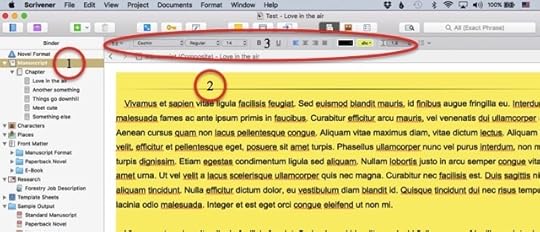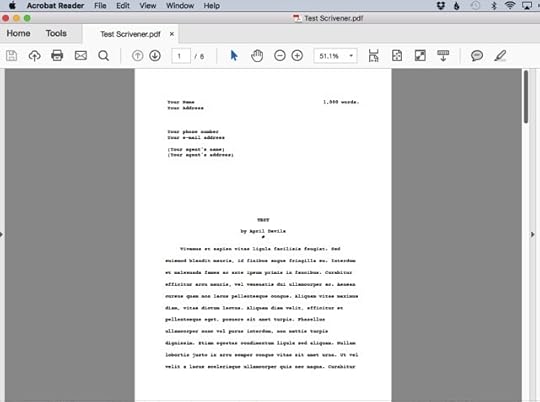April Davila's Blog, page 31
October 8, 2019
Writing Tip Tuesday: Ellipses
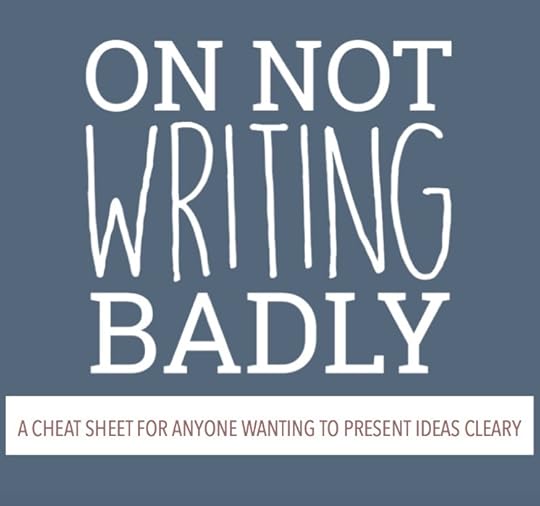
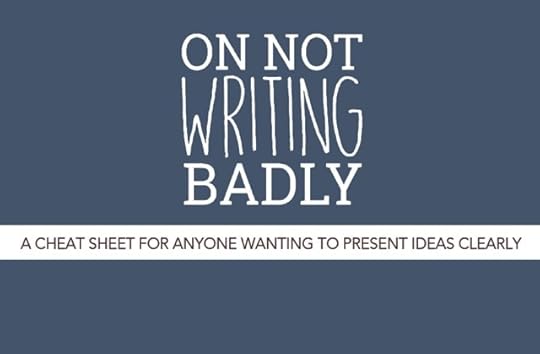 Welcome to Writing Tip Tuesday, the Ellipses edition. This is the tenth in a series of posts pulled from my free guide “On Not Writing Badly.” You can download the whole thing by filling out this form, or, if you’d rather not subscribe to my email list, you can simply check back here over the next several Tuesdays for a regular dose of word nerdery.
Welcome to Writing Tip Tuesday, the Ellipses edition. This is the tenth in a series of posts pulled from my free guide “On Not Writing Badly.” You can download the whole thing by filling out this form, or, if you’d rather not subscribe to my email list, you can simply check back here over the next several Tuesdays for a regular dose of word nerdery.
Ellipses
Ellipses are used to show that a word or phrase has been deleted from a quoted passage.
Rule 1: Do not use ellipses before the first word of a quotation, even if the
beginning of the original sentence has been omitted.
Correct: “The man is a cheat.” Incorrect: “…The man is a cheat.”
Rule 2: Do not use ellipses after the last word of a quotation, even if the end of
the original sentence has been omitted.
Correct: “I hate that guy so much.” Incorrect: “I hate that guy…”
Rule 3: The first word after ellipses points is capitalized if it starts a complete
sentence, even if it was lowercase in the original.
Scott said: “Why do I hate him?… He is always stealing my pen.”
Rule 4: We do use punctuation (including periods) before ellipses points, when
they are needed for clarity. See the example for Rule 3.
(Note: This is one of those contentious grammar issues your momma warned you about.)
October 7, 2019
Formatting Fonts in Scrivener
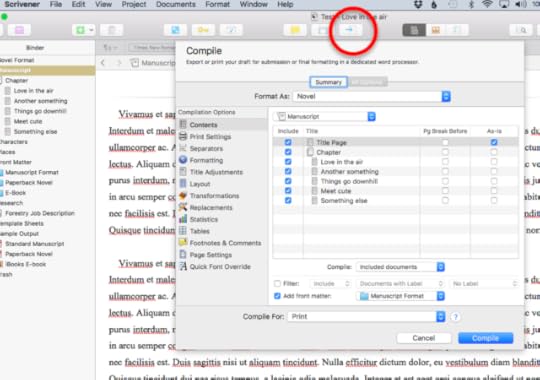
One of the things I like about Scrivener is that it exports my work in a format that makes me look super professional, but allows me to work in any font, in any size, like it’s our little secret. Here’s how it works.
How To Set The Format You See While You’re Working
There are two ways to adjust what your project looks like while you’re working on it.
Method One:
1. click on the manuscript icon in the binder to select the whole project
2. click in the body of the story and select all
3. simply adjust using the buttons at the top of the screen (similar to how you would in Word)
Method Two:
Create a preset format. This is a little more involved, and I’m not sure I understand the benefit gained by the extra steps, but if you’re curious, check out this video. It’s quite long, but starting at minute 2:30, they go into detail about preset formats. They even walk through the steps on both Mac and PC.
The great thing is that, no matter what settings you use for your manuscript while you’re working on it, Scrivener will export your work according to industry standards. So you can work in 20 point Andale Mono if you want. Heck, make all your words green if you want. Do whatever works best for you. It’s your work.
How To Export Like a Pro
When you’re ready to export your work, simply click on the little icon at the top that looks like a page with an arrow on it.
If you leave all the format settings alone and simply export into word or to a PDF, Scrivener will automatically make it look perfect (that is to say, the resulting document will look like something that an agent or an editor will see as professional). Something like this:
And that’s that. A quick easy trick for making Scrivener work for you.
Now go get writing already.
Scrivener Webinar
On October 13, 2019, I will be teaching a webinar titled “Demystifying Scrivener.” This crash course will explore the myriad ways in which Scrivener can make your writing process smoother and more organized. If you haven’t yet purchased Scrivener (or are using the free trial version), you can get 20% off the purchase price when you register for the webinar. Suitable for new Scrivener users as well as long-time users who want to learn how to use the program more effectively. To sign up, visit the Pen & Paper Writing Workshops website.
October 4, 2019
Tie-Dye California

 This post is part of an extended series I’m writing about California.
This post is part of an extended series I’m writing about California. You can find out more on my Why California page.
Though tie dying was hardly invented in San Francisco, it has become a standing symbol of the hippie mentality that flourished in the Northern California in the late 1960’s.
A group called The Diggers, who prided themselves on being the anti-establishment of the anti-establishment crowd, set up a “free store” in the Haight-Ashbury district of San Francisco where people could get clothing and food at no cost.
To personalize the second-hand duds, as well as to declare themselves apart from mainstream society, hippies utilized dying techniques gleamed from India, Japan and Africa to color the clothing in elaborate, colorful designs.
One of the most famous practitioners of tie dying was Ann Thomas, also known as “Tie-Dye Annie.” She was quoted in a 1970 issue of Time magazine as saying “It was the only way we had to give (the clothes) our own individual stamp of identity, as well as making them beautiful.”
Since then tie dye has come in and out of fashion, even falling into the hands of Oscar De La Renta whose tie dyed trench coat was displayed in the San Francisco’s De Young Museum during the last half of 2010.
October 2, 2019
I’d Rather Be Shot In The Street


I keep things pretty professional here on the blog, but there’s something that’s been on my mind, and I just need to rant a little… Bear with me.
Because there’s a certain story device that has always bothered me and I feel it’s my duty, as someone who writes about the craft of writing, to bring it to the attention of other writers out there, so that, together, we can stamp out this stupid plot device.
Forced Into A Car At Gunpoint
You’ll see it in the scene where the hero is walking along and the car/van pulls up beside them and points a gun at them and they get in the car. This is a terrible story device (unless your main character is an idiot). I always want to scream at the TV/movie screen/book whenever it comes up (which it does a lot) “don’t do it, you idiot!”
It’s such a stupid plot device. Here’s why:
If you’re being kidnapped by a stranger, than you’re an effing idiot to get in the car if someone points a gun at you. What exactly do you think the plan is exactly? Take you to the spa for a little quiet time away from the dog-eat-dog world we live in?
No, they’re going to kill you, or worse (especially if you’re a woman) – and they’re going to do it at their leisure, in the private spot of their choosing, and then they’re going to dispose of your body where no one will ever find it.
I say, if you’re going to shoot me, do it right there in the damn street, where there will be evidence, and (hopefully) witnesses and the cops will be on your ass within the hour.
At the very least, my mom will know I was shot and left for dead and won’t lay awake at nights wondering why I disappeared or where I am. (Not that I hope to ever be shot, mind you, I’m just saying – if I HAVE to be shot, I’d rather it be in a public place.)
The Exception
I can almost understand this device in political thrillers – where the hero knows that there are larger issues at stake. I seem to remember a scene where someone is kidnapped by a dignitary or something, so the hero knew who it was.
In that case, you (as the writer) shouldn’t even need to bring a gun into it. If you (the writer) have done your job in setting up the stakes, the gun is unnecessary – the whole world will die if he/she doesn’t get in that car.
But Really
So you see, there’s no good reason to use this device of the gun coming out of the car/van window and forcing someone to get in. Unless, of course, your hero isn’t too bright. I guess that would be a valid reason. But if that’s the case, the rest of your story better pretty damn entertaining (“The Man Who Knew Too Little” comes to mind – I love that film).
And don’t even get me started on the scene where the poor sap is digging his own grave at gun point (I’m looking at you “24”). If anyone ever tells me to dig a hole so they can shoot me and bury me in it, I plan on giving them the finger and letting do their own dirty work.
Consider this my Monday public service announcement for all you writers out there.
You’re welcome.
October 1, 2019
Writing Tip Tuesday: Bullet Points
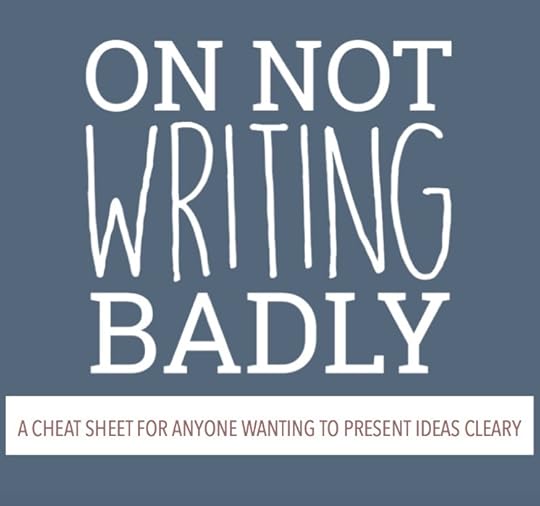
 Welcome to Writing Tip Tuesday, the Bullet Points edition. This is the ninth in a series of posts pulled from my free guide “On Not Writing Badly.” You can download the whole thing by filling out this form, or, if you’d rather not subscribe to my email list, you can simply check back here over the next several Tuesdays for a regular dose of word nerdery.
Welcome to Writing Tip Tuesday, the Bullet Points edition. This is the ninth in a series of posts pulled from my free guide “On Not Writing Badly.” You can download the whole thing by filling out this form, or, if you’d rather not subscribe to my email list, you can simply check back here over the next several Tuesdays for a regular dose of word nerdery.
Bullet Points
Rule 1: If your bullet points are not complete sentences you do not need punctuation or capitalization.
I love three flavors of ice cream:
chocolate
coffee
salted caramel
Rule 2: Do not use commas, semicolons, or “and” at the end of each line. Just let it be.
I have three dogs:
Daisy
Lupe
Fart Bucket
Rule 3: If your bullet points are complete sentences, do use punctuation and capitalization.
These are the pool rules:
Do not run.
If you see unsafe behavior, report it to the lifeguard.
Did you remember your towel?
Have fun!
Rule 4: Use numbered bullet points when the order of the items is important.
How to eat ice cream:
Get a spoon.
Open the container.
Dig in.
September 30, 2019
Tidying Up Those Double Spaces in Your Manuscript

 I was doing some freelance work a while back, working with a small marketing team, and I was lamenting the prevalence of double spaces after periods. It’s a pet peeve of mine. The woman I was working with, who was about fifteen years younger than me, voiced her theory that people tend to hit the space bar twice because that’s how texting works (for the old fogies who don’t know, if you hit the space bar twice while you’re texting, you automatically get a period – very handy).
I was doing some freelance work a while back, working with a small marketing team, and I was lamenting the prevalence of double spaces after periods. It’s a pet peeve of mine. The woman I was working with, who was about fifteen years younger than me, voiced her theory that people tend to hit the space bar twice because that’s how texting works (for the old fogies who don’t know, if you hit the space bar twice while you’re texting, you automatically get a period – very handy).
I paused for a moment and said something that made me sound really old, something like “that’s why someone from YOUR generation might hit the space bar twice, but in MY DAY, when we learned to type on typewriters, we were taught to hit the space bar twice after a period to give a little extra space before beginning a new sentence.” Nothing says “over 40” like those double spaces.
To be fair, because I’m really not THAT old, I fall somewhere in between. I actually learned to type on a word processor. A Brother (anyone remember those?). And by then you didn’t have to hit space twice because the computer automatically put 1.5 spaces after a period.
But whatever the reason, there is a whole contingency of people who put two spaces after every period. So I’d like to state for the record: you don’t have to do that. ALL modern fonts put 1.5 spaces after a period, so that you get that elegant bit of extra space before the next sentence starts.
Cleaning Up in Word
Most word processing programs have a find-and-replace function, so if you have a manuscript full of double spaces, all you have to do is use this function to clean up your document. In Word, for instance, go to Edit -> Find -> Replace. In the “find” field enter two spaces. In the “replace” field enter one. It will look a little strange, since you don’t actually see anything in either field, but hit “Replace All” and the program will automatically tidy everything up for you.
If you’re one of those people who kind of goes crazy with the space bar every now and then, hitting it two or three or even four times, you might have to repeat the above process a few times, replacing three or four spaces with one.
Tidying Up in Scrivener
If you have Scrivener, it’s even easier to clean up your manuscript. Just go to Edit -> Text Tidying -> Replace Multiple Spaces With Single Spaces.
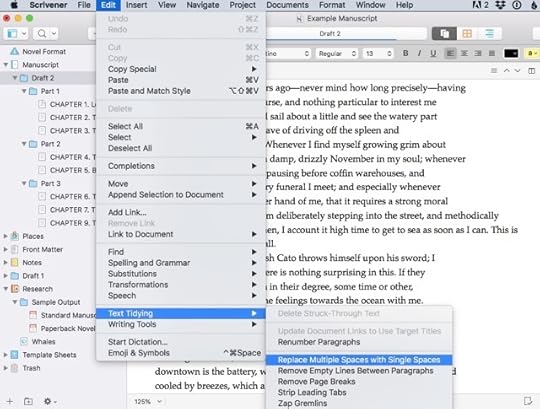
You’ll also see options there to remove extra lines or page breaks. These are new since the 3.0 upgrade. Pretty cool. Especially when you get to the point that you’re doing a final polish for publication. Yeah Scrivener!
And down with unnecessary spaces!
Scrivener Webinar
On October 13, 2019, I will be teaching a webinar titled “Demystifying Scrivener.” This crash course will explore the myriad ways in which Scrivener can make your writing process smoother and more organized. If you haven’t yet purchased Scrivener (or are using the free trial version), you can get 20% off the purchase price when you register for the webinar. Suitable for new Scrivener users as well as long-time users who want to learn how to use the program more effectively. To sign up, visit the Pen & Paper Writing Workshops website.
September 27, 2019
California Sea Otters

 This post is part of an extended series I’m writing about California.
This post is part of an extended series I’m writing about California. You can find out more on my Why California page.
As members of the weasel family, California sea otters can walk, but they prefer to spend their lives in the water, sleeping, frolicking and continually stuffing their faces.
Sea otters eat a quarter of their body weight every day, diving up to 350 feet to seek out abalone, urchins, crabs and clams, which they crack open with sharp stones. When it’s time to rest, they wrap themselves in kelp to keep from floating away, before pulling their paws up under their chins to sleep in a posture that is undeniably cute.
Unlike other marine mammals, they have no blubber. Instead, every inch of the sea otter’s pelt has over 850,000 hairs that trap air bubbles and maintain the otter’s body heat. Unless their fur is matted (for instance in an oil spill), water never actually touches the otter’s skin. They spend a quarter of their time grooming, to keep their protective furs in good shape.
In the late 1700s humans came to appreciate their warm coats as well, and by 1820 they were nearly extinct. During the 20th century conservation efforts helped the otter population rebound, but they are still listed as an endangered species.
September 25, 2019
The 25/5 Rule


I love reading about tricks that business moguls use to hone their skills and build their empires. I find, over and over, that a surprising number of the ideas in business books can be easily applied to a writing career. Even though I have no desire to ever be a CEO or mastermind a hostile takeover, I do take my chosen profession seriously and so I occasionally read a bit on the topic of career building.
A few days ago I came across an article on Inc.com about Warren Buffett’s 25/5 Rule and it was one of those moments where I thought “yep, this totally applies to me.”
Here’s the gist: you write a list of the 25 things that you most want to achieve in life. Then you circle the top 5 and swear off the other 20. Just cut them loose. The idea being that those are the things you are most likely to get distracted by. You care about them, but they’re not you’r top priorities, and if you ever want to achieve those top five, you have to make room for them by not letting the other twenty get in the way.
My List
I’m not going to give you my whole list, but I will share my top five:
raise my kids wellwrite a novel every three years (going for an average here)exercise six days a weektravel to as many places in the world as I possibly canread all the books
A few things that didn’t make the top five:
have a gardenrun a marathontake a dance classes painting/drawing/art of some kindplay guitar
My heart aches a little, looking at that list. Because I really always dreamed of running a marathon. And I optimistically start a garden in a little patch of backyard at least once a year (and then watch it die when I don’t have time to tend it).
In short, I struggle with the reality that my time is limited. It is one of life’s greatest tragedies that I will never be able to do all the things I would like to do with this one short life.
But, Really?
So of course, my mind starts negotiating with itself. I could exercise six days a week by training for a marathon, right? I totally could, but then I remember when I ran my half marathon, how I would spend hours out on training runs. I don’t really have time for that (and more) right now, when I could walk the dogs for 20 minutes and call it good for the day (in terms of exercise).
Then there’s my blog (my two blogs, actually – this one and my weekly LitWeekLA newsletter). I count these as part of my writing career as well, but should I? They don’t directly contribute to completed novels. There are certainly writers out there who have never written a blog post in their life. And if I’m honest, I often hear a little voice in the back of my head (like right now as I write these words) that nags: you could be working on your novel.
But I enjoy blogging. And it’s a way to connect with other readers and writers out there, so it does feel justifiable as part of a writing career, at least as I have embraced my own thus far.
Changes to the Top 5
Then I start thinking about what factors could influence my list. One is parenthood. At some point the actual work of raising my kids will consume far fewer hours in my day. Eventually they will go off to college, and though I will always be their mom, “raising” them won’t really be on my to do list anymore.
Then there are financial considerations, of course. I certainly didn’t get into literary fiction for the paycheck (duh), but I wonder sometimes if I prioritized money, would I make more?
For instance, teaching didn’t make the top five, but it is something I’ve always been interested in doing. And it does pay. Not a lot, but still – money. The trade off is writing time. Is the money I make teaching worth publishing a book every 4 or 5 years instead of 3? I guess it depends on how much money I make with my fiction in the coming years, which is totally unknowable, which has my head running in circles.
No wonder Warren Buffett never wrote fiction.
Anyway… would love to hear what other people have on their lists. How do you decide what makes the top five and what gets bumped? How much is about passion? How much is dependent on practical concerns?
September 24, 2019
Writing Tip Tuesday: Colons & Semicolons

 Welcome to Writing Tip Tuesday, the Colons & Semicolons edition. This is the eighth in a series of posts pulled from my free guide “On Not Writing Badly.” You can download the whole thing by filling out this form, or, if you’d rather not subscribe to my email list, you can simply check back here over the next several Tuesdays for a regular dose of word nerdery.
Welcome to Writing Tip Tuesday, the Colons & Semicolons edition. This is the eighth in a series of posts pulled from my free guide “On Not Writing Badly.” You can download the whole thing by filling out this form, or, if you’d rather not subscribe to my email list, you can simply check back here over the next several Tuesdays for a regular dose of word nerdery.
Colons & Semicolons
Colons
Rule 1: Colons can be used after a phrase (of one word or more) to indicate that
something more is coming.
Example:
Rule 1:
Rule 2: Colons can be used to introduce a series of items. They should generally be
preceded by a complete sentence. When used accurately, they could be replaced with a comma and “namely.”
We need an assistant with office skills: typing, inputting data, and completing
tax forms.
We need an assistant with office skills, namely typing, inputting data, and
completing tax forms.
Rule 3: When a complete sentence comes after a colon, the first word in that sentence should be capitalized.
For example: This is a complete sentence.
Semicolons
Rule 1: Semicolons separate complete sentences that are closely related.
Mary ate dinner; the food was delicious.
Note: The word after the semicolon is not capitalized unless it is a proper noun.
Rule 2: Semicolons can be used in complex sentences where commas would be
confusing.
The conference has people who have come from Sand Point, Idaho;
Springfield, California; and other places as well.
Colons and Semicolons Together
Though it is often easier to use bullet points, or break a longer thought into multiple sentences, you can use a colon to introduce ideas, and semicolons to separate them.
We believe there are many reasons to move forward with the project:
Julie and her partner, the executive director, have lined up the funding;
the participants, all 15 of them, have blocked out the time on their
calendars; we’re tired of waiting.
Note: The words between each semicolon create a complete sentence, and the first
word after each semicolon is not capitalized.
September 23, 2019
Comments & Footnotes in Scrivener
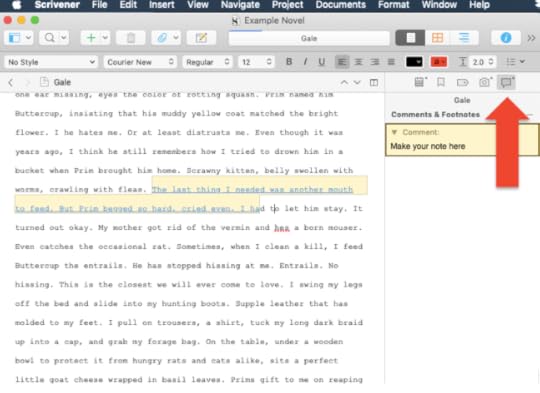
We’re continuing the #52WeeksOfScrivener series today by working our way through the Inspector window. Last week we talked about using Snapshots. Today: Comments & Footnotes.
Nothing in this section is rocket science, but I thought I’d just run through all the functionality, in case anything has escaped your attention.
First thing’s first, click the Comments & Footnotes icon in your Inspector window:

Add A Comment
In your manuscript, when you want to make a note, simply highlight the text you want to attach the note to, then click the smaller little comment icon:
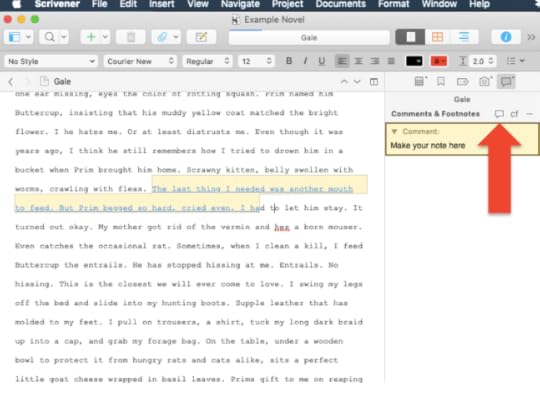
A box will automatically appear here with your name and the date. You can leave that info and add your note after it (this is handy if you’re co-writing or giving notes on a project that isn’t your own), but I usually type over that info, since I’m the only one working on my project.
Footnotes
Footnotes differ from Comments insofar as they are intended to show up on the printed page. But adding them is very much the same as adding a comment, just click on the little “cf” next to the Comment icon:
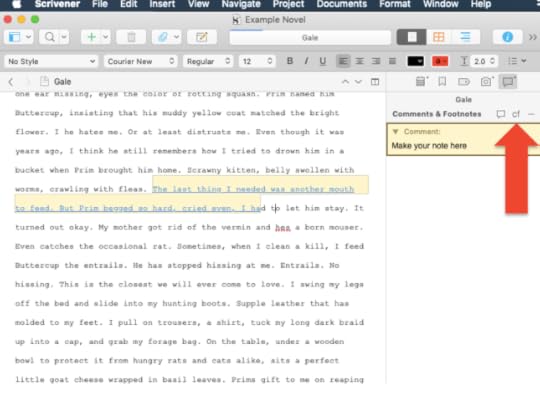
Delete Comments & Footnotes
To delete a comment or footnote, simply click on the one you want to delete and then click the little minus sign:

OR, if you hover over the comment, a pale “X” will appear at the top right of the square. You can also click that.
Other Things To Know
You can collapse and expand comments by clicking on the little triangle on the left side:
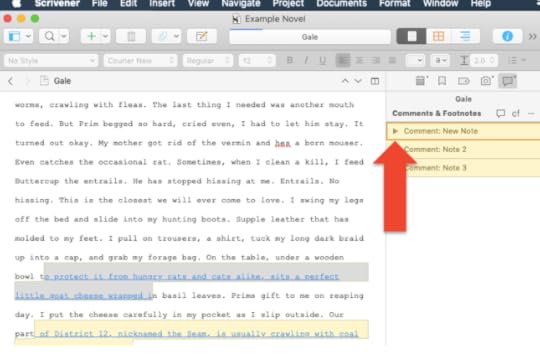
By Right Clicking on a comment (or using Control Click), you get a few more options, like color coding or converting a comment into a footnote:
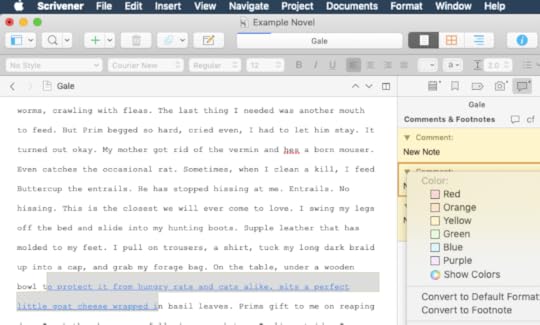
By Right Clicking on a comment (or using Control Click), you can go to “Zoom” in the drop down and make the notes larger:
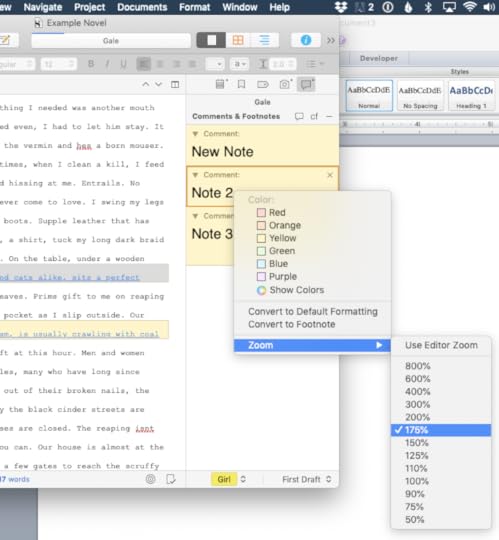
And I think that’s about everything I can tell you about Comments & Footnotes.
Scrivener Webinar
On October 13, 2019, I will be teaching a webinar titled “Demystifying Scrivener.” This crash course will explore the myriad ways in which Scrivener can make your writing process smoother and more organized. If you haven’t yet purchased Scrivener (or are using the free trial version), you can get 20% off the purchase price when you register for the webinar. Suitable for new Scrivener users as well as long-time users who want to learn how to use the program more effectively. To sign up, visit the Pen & Paper Writing Workshops website.
Next Week
Next Monday we will move on from the Inspector and I’ll show you a neat little trick for cleaning up your manuscript before you print it out. Stay tuned, follow on Twitter with #52WeeksOfScrivener, or sign up for my newsletter to get a weekly digest of all my posts.

